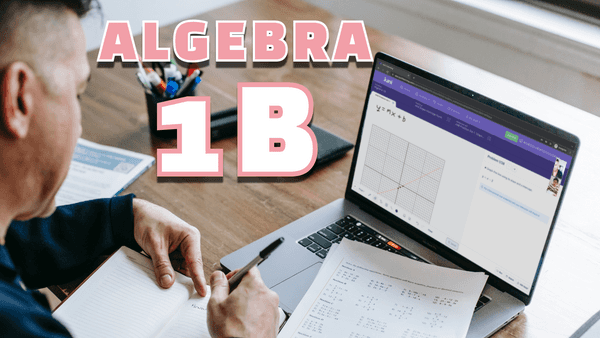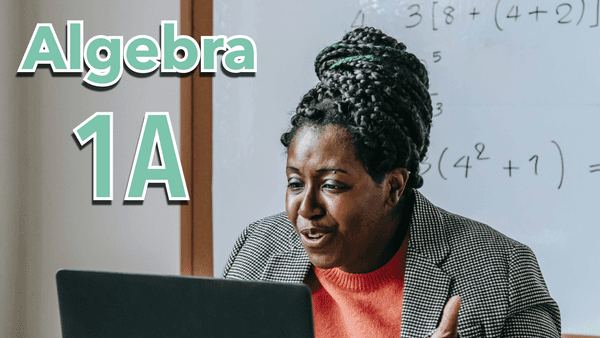Algebra 1B
Algebra 1 is students’ first exposure to pulling their math knowledge together towards a more rigorous and visual understanding of mathematics. Concepts from this course are heavily applicable to future upper-level math courses and extensively tested on the SATs, ACTs, and more.

- Private 1:1
- Format
- Age 12-15
- Learners
- Weekly
- Classes
- 50 minutes
- Per class

About this Course
Billing
Billed as
$275 / month
Scheduling
1:1 classes are 50 minutes long and can be scheduled anytime Monday-Sunday from 7am to 7pm PT. To begin, select Book your Placement Class to signup. Our team will then match you and set up your first class!
- Course duration4-6 months
- Lesson50 minutes
Learning Targets
Polynomials
Polynomials-1: The student can explain what a polynomial is.
Polynomials-2: The student can identify the degree of a polynomial.
Polynomials-3: The student can simplify a polynomial by combining like terms.
Polynomials-4: The student can add and subtract polynomials.
Polynomials-5: The student can multiply a polynomial by a constant.
Polynomials-6: The student can multiply binomials using FOIL.
Polynomials-7: The student can perform complex polynomial multiplication.
Polynomials-8: The student can rationalize a denominator.
Polynomials-9: The student can add and subtract fractions with polynomials.
Factoring Quadratics
Factoring-1: The student can factor a polynomial using the GCF method.
Factoring-2: The student can factor a polynomial using the FOIL method.
Factoring-3: The student can recognize and factor an expression that is a binomial square.
Factoring-4: The student can recognize and factor an expression that is a difference of squares.
Factoring-5: The student can recognize and factor an expression that is a difference of cubes.
Solving Quadratics
Solving-1: The student can solve a quadratic equation by factoring.
Solving-2: The student can solve a quadratic by completing the square.
Solving-3: The student can solve a quadratic using the quadratic formula.
Solving-4: The student knows what complex numbers are.
Solving-5: The student can simplify expressions in terms of i.
Solving-6: The student can use the discriminant to determine the number of roots the equation has and whether they are real or non-real.
Solving-7: The student can solve for non-real solutions using the quadratic formula.
Graphing Quadratics
Graphing-1: The student can plug values into a quadratic equation to find points on its parabola.
Graphing-2: The student can graph a parabola by points.
Graphing-3: The student can identify the axis of symmetry of a parabola.
Graphing-4: The student can identify the coordinates of the vertex of a quadratic in vertex form.
Graphing-5: The student can identify the coordinates of the intercepts of a quadratic in intercept form.
Graphing-6: The student can find the standard form equation of a quadratic given 3 points.
Graphing-7: The student can convert a quadratic between vertex form and standard form.
Graphing-8: The student can convert a quadratic between intercept form and standard form.
Transformations
Transformations-1: The student can perform vertical and horizontal translations.
Transformations-2: The student can scale an equation up or down by a factor.
Transformations-3: The student can reflect an equation across the x-axis.
Transformations-4: The student can reflect an equation across the y-axis.
Transformations-5: The student can apply multiple transformations to a quadratic.
Functions
Functions-1: The student can explain what a function is.
Functions-2: The student can find the output of a function given the equation of the function and an input.
Functions-3: The student can identify the domain and range of a function given the equation.
Functions-4: The student can identify any relative/absolute minima/or maxima of a function given the graph.
Functions-5: The student can identify the intervals over which the function is increasing or decreasing given the graph.
Functions-6: The student can determine if a given graph is a function or not.
Functions-7: The student can combine functions using addition, subtraction, multiplication, and division.
Functions-8: The student can compose a function from two other functions.
Functions-9: The student can compute the output of a composite function.
Functions-10: The student can find the inverse of a given function.
Special Functions and Data Modeling
Advanced-1: The student can determine if a function has an inverse by looking at its graph.
Advanced-2: The student can identify an absolute value function from its graph.
Advanced-3: The student can write an exponential function that models a situation in a word problem.
Advanced-4: The student can solve an exponential function.
Advanced-5: The student understands what an inverse variation is.
Advanced-6: The student can find the value k of an inverse proportion given x and y.
Advanced-7: The student can calculate the asymptotes of a given rational expression.
Advanced-8: The student can tell which trends are more or less correlated.
Advanced-9: The student can calculate which equation fits the data better using residuals.
General Mathematical Skills
I can explain what the question is asking for.
I can explain my thinking behind my work.
I check my work carefully during or after I finish a question.
When I am stuck on a question, I show perseverance by trying a new method or asking for help.
When I am stuck on a question, I use what I know to find a place to start.
General Learning Habits
Joyful Collaboration
- I practice listening to my instructor and sharing my ideas to co-create understanding.
- I attempt tasks independently and ask my instructor questions when I need help.
Unlimited Curiosity
- I take ownership of my learning by asking meaningful questions both when I need clarification and when I want to know more about a topic.
Nimble Determination
- I practice resilience when I am frustrated that I have not yet achieved mastery of a new concept or skill; instead of complaining about challenges, I try new approaches and creative solutions.
Investment in Excellence
- I arrive to class on time and prepared to learn, with my computer set up with a strong internet connection.
- I complete my homework on time, and if I cannot complete my homework due to other obligations, I honestly communicate the reasons for late homework to my instructor.
- I do my best to stay present and on task for the whole session. I support my focus by putting away any distracting technology and setting notifications on my device to “do not disturb” mode.
Homework
Instructors will assign students roughly 60 minutes of class related problems at the end of each session. Homework is generally pulled from Juni's curriculum and is meant to complement the class experience and ensure the student continues to learn and grow outside of the session
Pre-Requisites
Completion or demonstrated understanding of topics within Algebra 1A
Who are Juni’s Instructors?
Our instructors are subject matter experts from top US universities. Instructors are highly-vetted and background checked prior to joining and undergo extensive training before ever teaching on our platform.
Upon signing up, parents are asked a series of questions that allow us to match your child with an optimal instructor based on their unique needs and interests. Factors that are considered in our matching process include Learning Style, Personality, Personal Experience, and Academic & Career Aspiration.





